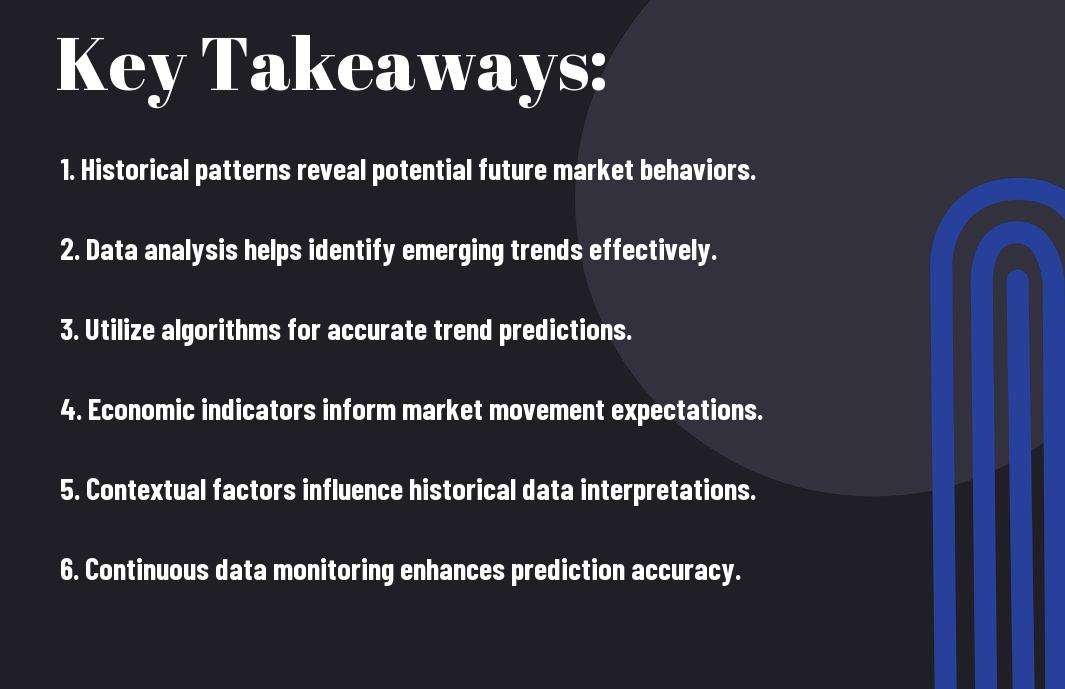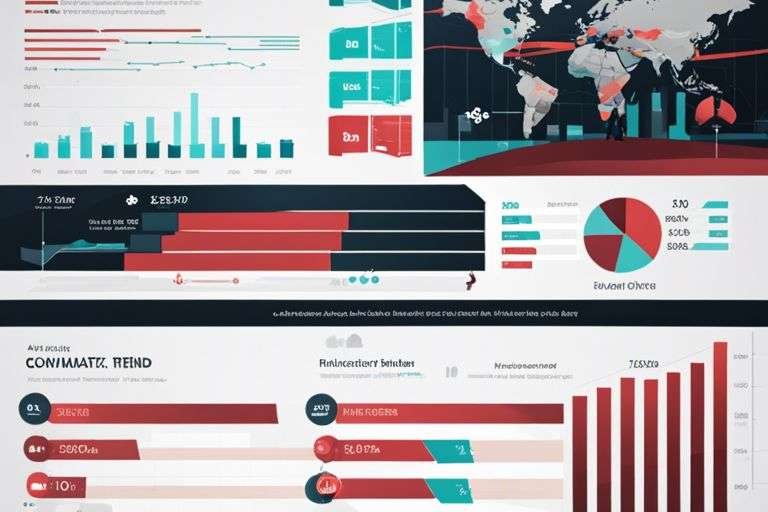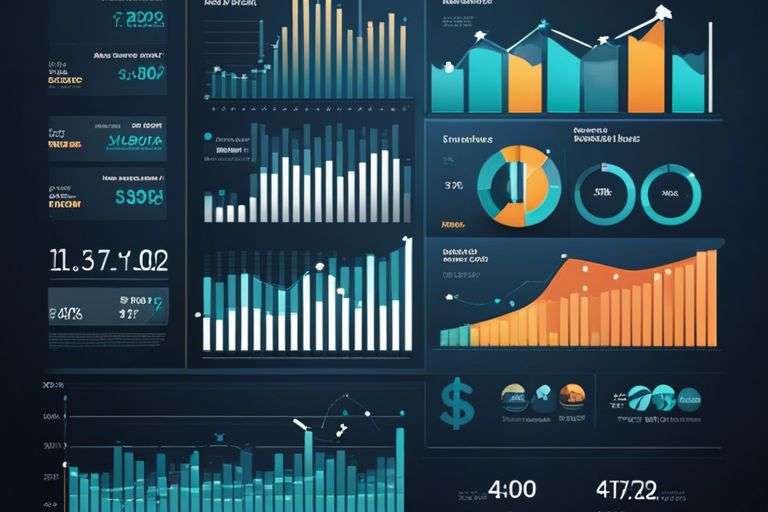It’s vital for you to understand that analyzing historical data can significantly enhance your ability to predict future market trends. By examining past performance, patterns, and consumer behavior, you can uncover key insights that can inform your decision-making and strategic planning. This skill not only helps mitigate potential risks but also positions you for greater success in a constantly evolving market landscape. In this blog post, you will learn effective techniques and tools to leverage historical data in making informed predictions about future market dynamics.
Key Takeaways:
- Historical Patterns: Analyzing past market trends can reveal recurring patterns that may repeat, providing insight into future behavior.
- Data Sources: Leveraging multiple data sources, including economic indicators and consumer behavior, enhances the accuracy of market predictions.
- Statistical Techniques: Employing advanced statistical techniques such as regression analysis and time-series forecasting allows for robust predictions based on historical data.

Understanding Historical Data
Your journey into market trend analysis begins with a firm understanding of the historical data surrounding those trends. Historical data refers to the collected records of past events and activities within the market that provide a comprehensive backdrop for current decision-making and future predictions. Understanding this data is important, as it not only sheds light on past market behaviors but also helps identify patterns and trends that can inform your strategic decisions. It serves as a foundation upon which effective forecasting and analysis can be built.
Definition and Importance of Historical Data
One of the primary reasons historical data is important in market analysis is its ability to highlight market cycles and fluctuations over time. This data encapsulates the performance metrics, sales figures, consumer behavior, and economic indicators that can help you gauge the underlying dynamics of the market. By reviewing and analyzing historical data, you can uncover valuable insights into seasonal trends, competitive performance, and economic shifts that have a direct impact on future market conditions.
Types of Historical Data in Market Analysis
For a comprehensive market analysis, you will encounter multiple types of historical data that can significantly influence your forecasting capabilities. The main categories of historical data often include:
| Price Data | Past records of prices for various assets or commodities. |
| Volume Data | Information on the number of units sold or traded over a given period. |
| Economic Indicators | Data reflecting the overall economic condition, such as GDP, inflation, and employment rates. |
| Consumer Behavior Data | Insights into purchasing trends and customer preferences. |
| Competitive Analysis | Comparative metrics to assess competitors’ performance. |
This diversified collection of historical data enables you to make informed predictions about future market movements. As you analyze this information, it becomes evident that understanding the underlying factors tied to economic trends and consumer behavior will prove invaluable. Thou must ensure you consider both quantitative and qualitative dimensions to enrich your market analysis effectively.
Data Collection Methods
Methods for collecting historical data vary widely and play a critical role in ensuring the reliability and validity of your analysis. You may utilize both primary and secondary data collection techniques. Primary data involves gathering fresh data directly from the source, while secondary data utilizes existing information collected by others. Moreover, the selection of a suitable method often depends on the specific requirements of your analysis, resource availability, and the scope of the data you wish to examine.
To enhance the integrity of your findings, it is important to employ rigorous data collection methods. You should consider utilizing surveys, market reports, interviews, and academic publications for primary data while refining your approach to include reputable sources for secondary data. The successful amalgamation of these methods results in a robust dataset, providing you with a comprehensive view of market history. Thou must pay close attention to the quality and accuracy of your sources in order to make well-informed predictions.
Importantly, reliable data collection methods are vital for successful market trend analysis, and they can directly affect the outcomes of your predictions. When gathering historical data, be certain to implement systematic approaches to data validation, as this ensures precision and reduces the likelihood of errors that may potentially skew your analysis.

The Role of Statistical Analysis
Some of the most effective methods for predicting future market trends rely heavily on statistical analysis. This field encompasses various techniques and methodologies designed to interpret complex datasets, allowing you to derive meaningful insights that can inform your investment decisions and strategies. By leveraging historical data, you can better understand the relationships between different variables and how they may impact future market movements.
Descriptive Statistics and Their Uses
Statistical analysis begins with descriptive statistics, which provide a summary of your data through measures such as mean, median, mode, and standard deviation. These statistics allow you to obtain an overview of your dataset, enabling you to identify trends, patterns, and outliers that may influence your market predictions. For instance, by examining the average returns of a particular stock over a set period, you can gauge its volatility and potential for growth, helping you make more data-driven decisions.
Additionally, descriptive statistics can help you visualize data through charts and graphs, making it easier to convey your findings to stakeholders or team members. Utilizing these visual tools, you can enhance your understanding of the market landscape, identify areas of opportunity, and evaluate the performance of different assets in your portfolio. This foundational step is crucial to building a robust analysis that informs your market forecasting.
Inferential Statistics for Market Predictions
Statistics goes a step further with inferential statistics, which allows you to draw conclusions about a larger population based on a sample of data. This is particularly useful when you want to predict market trends while dealing with limited data. By applying techniques such as hypothesis testing and confidence intervals, you can estimate trends with a certain degree of reliability, giving you the confidence to act upon your findings. For example, if you observe a performance pattern in a sample of stocks, you can infer that similar trends may exist in the overall market.
The combination of inferential statistics enables you to identify correlations among various factors affecting the market. This can help you predict future behaviors by establishing a mathematical relationship between independent and dependent variables. Using these insights, you can not only enhance your strategy but also mitigate risks when committing capital to different investment avenues.
Common Statistical Tools and Software
Statistics plays a pivotal role in the functionality of various statistical tools and software designed for market analysis. Some widely used programs like R, Python, and Excel help you manage and analyze vast datasets, making it easier to estimate trends effectively. By employing these tools, you can perform complex calculations, create visualizations, and even automate repetitive tasks, significantly enhancing your productivity as you analyze market data.
While choosing your statistical software, consider the level of complexity you anticipate in your analysis. Any data savvy individual can use Excel for basic functions, but for advanced statistical requirements, R or Python might be more appropriate. These stronger platforms not only accommodate deeper statistical evaluations but also foster collaboration and reproducibility of your findings, making your investment strategies even more credible.
Inferential statistics will prove to be crucial in your analytical arsenal, as it supports generalization from samples, enabling you to make predictions with confidence. This method allows you to identify potential market trends and adjust your investment strategies accordingly. Understanding the role of these statistical tools and techniques can enhance your ability to make informed and strategic decisions in today’s dynamic market landscape.
Identifying Trends in Historical Data
To effectively analyze historical data for predicting future market trends, you must first understand how to identify patterns that can give you insights into market behavior. By recognizing these trends, you can make informed decisions that could enhance your strategic approach. Employing various techniques allows you to probe deeper into the data, helping you to discern between transient fluctuations and significant shifts in the market landscape.
Trend Analysis Techniques
To begin your analysis, you can utilize several trend analysis techniques that can help in revealing underlying patterns within the historical data. One popular method is the use of quantitative analysis, which uses mathematical models and statistical trends to predict future movements in the market. This can assist you in identifying both short-term and long-term trends, enabling you to make decisions that align with your investment strategy. Additionally, qualitative analysis offers insights based on market sentiment and external factors influencing the economy, giving you a more holistic view.
Moving Averages: Simple vs. Exponential
Identifying the right type of moving average is crucial as it can significantly affect your analysis of market trends. You may choose between Simple Moving Averages (SMA), which calculate the average of a set of values over a specified period, and Exponential Moving Averages (EMA), which give greater weight to more recent data points. The choice between these two can dictate how sensitive your analysis is to price changes and market fluctuations.
Historical data can be quite revealing when you utilize moving averages effectively. SMAs provide a smooth representation of trends, making them less reactive to price swings, while EMAs react more quickly to recent price changes. Your choice would depend on whether you prefer a clearer long-term trend (SMA) or a more responsive indicator (EMA) that can capture emerging trends in the market.
Seasonal Trends and Cycles
To analyze seasonal trends, you need to recognize that many markets exhibit repeating patterns during certain periods, which can be influenced by economic cycles, holidays, or even weather changes. Understanding these seasonal trends can help you anticipate potential market movements, allowing you to align your investment strategy accordingly. Identifying these cyclical behaviors ensures you can capitalize on predictable shifts, thus optimizing your entries and exits in the market.
Trends that are seasonal often repeat with a certain frequency, making it crucial for you to distinguish between cyclical patterns and one-off events. This can significantly impact your forecasting abilities if done correctly, as seasonal analysis allows you to prepare for market conditions you can expect to recur, thus enhancing your overall market strategy.
Modeling Future Market Trends
Introduction to Predictive Modeling
For those of you interested in how to forecast future market movements, it’s crucial to understand the concept of predictive modeling. Predictive modeling uses historical data and statistical algorithms to identify patterns and trends that can help make informed decisions about future market behavior. By leveraging this approach, you can enhance your ability to predict market shifts and optimize your strategies accordingly.
Predictive modeling operates on the premise that past behavior can be indicative of future results. Whether you’re analyzing stock prices, consumer demand, or economic indicators, employing this technique enables you to create powerful models that can guide your decisions, providing a competitive edge in the ever-evolving financial landscape.
Regression Analysis and Its Applications
To fine-tune your predictive capabilities, you should examine into regression analysis, which is a pivotal technique for examining relationships among variables. This statistical method allows you to understand how the dependent variable changes when one or more independent variables vary. When used effectively, regression analysis can give you insights into market trends and help in predicting potential future values based on historical data.
In your analysis, regression can be particularly beneficial in various applications, such as determining price elasticity, forecasting revenues, or analyzing customer behavior. This method enables you to quantify relationships and make data-driven predictions that can significantly impact your market strategies.
Analysis of your regression results will further illuminate the validity of your model’s predictions. By assessing the strength and significance of the relationships identified, you can prioritize your focus on the most influential factors that drive market trends, allowing you to enhance your forecasting accuracy.
Time Series Forecasting Methods
One key aspect of modeling future market trends is leveraging time series forecasting methods. These methodologies rely on historical data points collected at consistent intervals to predict future points in the series. Time series analysis is particularly invaluable because it takes into account the temporal order of the data, revealing seasonal patterns and trends that may not be immediately apparent through other analytical techniques.
Utilizing time series forecasting methods can empower you to make predictions based on not just trends but also the cyclical and seasonal fluctuations that can affect market performance. By understanding these patterns, you can develop strategies that effectively capitalize on anticipated market changes.
Series analysis can also be enhanced by incorporating advanced techniques such as ARIMA (AutoRegressive Integrated Moving Average) models and exponential smoothing. These sophisticated methods refine your forecasts, helping you to account for noise in the data and improve the precision of your future market trend predictions. Understanding how to implement and interpret these methods is crucial for anyone looking to make data-driven decisions in a complex market environment.
Incorporating External Factors
After analyzing historical data to predict future market trends, it is crucial to incorporate various **external factors** that could have a significant influence on these outcomes. Identifying and understanding these factors will provide a more holistic view of market dynamics. Here are some key external elements you should consider:
- **Economic Indicators**: GDP growth, employment rates, and consumer spending
- **Market Sentiment**: Public perception and behavioral economics
- **Technological Advancements**: Innovations that can disrupt market stability
- **Global Events**: Geopolitical shifts and natural disasters
Any comprehensive analysis must integrate these aspects to enhance predictive accuracy. For further insights, explore Understanding Trend Analysis and Trend Trading Strategies to grasp the nuances of these factors in relation to market trends.
Economic Indicators and Their Impact
Impact of **economic indicators** on market behavior cannot be overstated. Elements such as inflation, interest rates, and employment figures collectively shape investor confidence and spending patterns. When GDP growth is strong, for example, consumers tend to spend more, stimulating business profits and increasing stock prices. Conversely, high inflation can erode purchasing power, leading to a cautious market sentiment that may negatively impact stock performance.
Furthermore, these indicators often create a ripple effect across industries. For you, understanding these correlations is vital when predicting market trends. Keeping a close eye on these economic signals can offer you a tactical advantage in anticipating fluctuations in **market values**.
Market Sentiment and Behavioral Economics
Their influence on market fluctuations is profound. **Market sentiment** encapsulates how investors feel about the market – whether optimistic or pessimistic – and can often drive prices in a direction that may conflict with fundamental analysis. Behavioral economics adds another layer, as it examines how psychological factors influence investment decisions. For instance, during times of uncertainty, investors may panic-sell, further deteriorating stock prices, regardless of underlying company performance.
Understanding these dynamics enables you to better gauge market reactions. Recognizing that emotions often dictate decisions will aid you in developing a more logical approach to your trading strategy. You will find that aligning your decisions with sentiment trends can be beneficial, but also requires caution to avoid potential pitfalls.
Economic sentiment can shift swiftly with news events, influencing **market valuations** dramatically. Being attuned to these fluctuations allows you to better navigate your investment strategy and utilize sentiment to your advantage.
Technological Advancements and Disruptions
External factors such as **technological advancements** play a crucial role in shaping market trends. Innovations, whether in artificial intelligence, blockchain, or renewable energy, can disrupt traditional industries, altering the competitive landscape. For you, staying informed about technological changes helps predict which sectors may experience growth while others may decline. Understanding these trends allows you to strategically position your portfolio in anticipation of future market shifts.
Additionally, technological disruptions often come with both opportunities and risks. New tools can enhance productivity and profitability, yet they can also render existing business models obsolete. Awareness of these changes enables you to adapt your investment strategies promptly, aligning your portfolio with sectors poised for growth.
A clear understanding of these technological changes equips you to make more strategic investment decisions. By keeping abreast of innovation trends and potential disruptions, you can better navigate the unpredictability of market environments and identify lucrative opportunities before the masses do.
Limitations and Challenges
Despite the promising potential of analyzing historical data to forecast future market trends, you must be aware of certain limitations and challenges that can affect the accuracy of your predictions. Recognizing these hurdles is crucial for making informed decisions and avoiding misinterpretations that could impact your investments and business strategies.
Data Quality and Accuracy Issues
Issues surrounding data quality and accuracy can significantly distort your analysis. Not all historical data is created equal; it can be plagued by errors, inconsistencies, or gaps that can skew your understanding of market dynamics. If you rely on outdated or incorrect data, the conclusions you draw may lead to misguided actions. This means you should critically evaluate the sources and methods used to gather historical data, ensuring it is reliable and comprehensive.
Additionally, the way you process and interpret this data is equally important. Analyzing data without considering contextual factors, such as changes in regulatory frameworks or economic conditions, may result in oversimplified conclusions. Therefore, you must be diligent in your approach, scrutinizing the integrity of the data you employ in your analysis.
Unpredictable Market Dynamics
Data on historical performance may give you insights into overall trends; however, unpredictable market dynamics can disrupt these patterns in ways that history cannot adequately prepare you for. Market behaviors are influenced by a plethora of factors, including but not limited to technological advancements, consumer preferences, and geopolitical events. Sudden changes can lead to rapid fluctuations that historical data may not account for, complicating your forecasting efforts.
Another factor to consider is that external shocks—like natural disasters, pandemics, or significant political shifts—affect markets in unpredictable ways. These unforeseen events can render established trends obsolete. Therefore, you need to combine historical analysis with real-time data and qualitative insights to remain adaptable in the face of change.
Bias in Historical Data Interpretation
On occasion, bias in the interpretation of historical data can distort your understanding and analysis. This could stem from the selective use of data that confirms pre-existing beliefs or ignoring data points that diverge from the norm. Such biases might lead you to overconfidence in certain predictions while underestimating risks, which can compromise your strategic planning and investment decisions.
Plus, it is crucial to remain vigilant and objective during your analysis to minimize these biases. Implementing data triangulation methods, where you compare data from various sources and perspectives, can help in mitigating such risks. A comprehensive approach enables you to identify and account for potential biases, leading to a more nuanced understanding of market trends and ultimately improving your decision-making process.
Summing up
With this in mind, it’s crucial for you to recognize the immense value that analyzing historical data brings to predicting future market trends. By leveraging past performance, consumer behavior, and economic indicators, you can develop a more nuanced understanding of your market dynamics. This approach not only equips you with the insights necessary to make informed decisions but also helps in anticipating potential challenges and opportunities, allowing you to stay ahead of the competition. Ultimately, mastering data analysis will provide you with the tools needed to navigate the complexities of the marketplace with confidence.
Your ability to synthesize historical data into actionable predictions will empower you to calibrate your strategies effectively. As you familiarize yourself with various analytical techniques—like regression analysis, time series forecasting, and pattern recognition—you will enhance your capability to spot trends before they fully materialize. Adopting a proactive stance based on these insights can significantly influence your strategic initiatives, whether they pertain to marketing, product development, or financial planning. By investing in your data analysis skills, you are not only securing your position in the market but also fostering resilience for future uncertainties.
FAQ
Q: What is historical data analysis in the context of market trends?
A: Historical data analysis involves examining past market data, such as prices, trading volumes, and economic indicators, to identify patterns and trends that can inform future market movements. This method allows analysts to uncover correlations and deviations that may not be apparent in current data alone. By leveraging statistical techniques and data visualization tools, investors can make informed predictions about future market behavior based on observed historical trends.
Q: How can historical data be effectively used to predict future market trends?
A: To effectively predict future market trends using historical data, analysts generally follow a systematic approach:
1. **Data Collection:** Gather comprehensive historical data covering the relevant time frame and market segments.
2. **Data Cleaning:** Process the data to remove anomalies or inaccuracies that can skew results.
3. **Pattern Recognition:** Utilize statistical models, such as time series analysis or regression, to identify significant patterns and relationships in the data.
4. **Backtesting:** Validate the predictive models by applying them to historical periods to see if they accurately forecasted past market movements.
5. **Forecasting:** Use the validated models to make informed predictions about future trends, incorporating additional factors like economic indicators, news events, and market sentiment.
Q: What limitations should be considered when using historical data to predict market trends?
A: While analyzing historical data can provide valuable insights, there are several limitations to consider:
1. **Market Changes:** Markets are influenced by numerous factors, including regulations, technology, and global events, which can alter historical patterns and relationships.
2. **Data Quality:** Inaccurate or incomplete historical data can lead to misleading predictions. It’s crucial to ensure data integrity and comprehensiveness.
3. **Overfitting:** There’s a risk of creating overly complex models that perform well on past data but fail to generalize to future scenarios. Simplifying models and using cross-validation techniques can help mitigate this risk.
4. **Unpredictable Events:** Events such as natural disasters, geopolitical shifts, or pandemics can significantly disrupt expected market behavior, making reliance on historical data alone insufficient for accurate forecasting.







